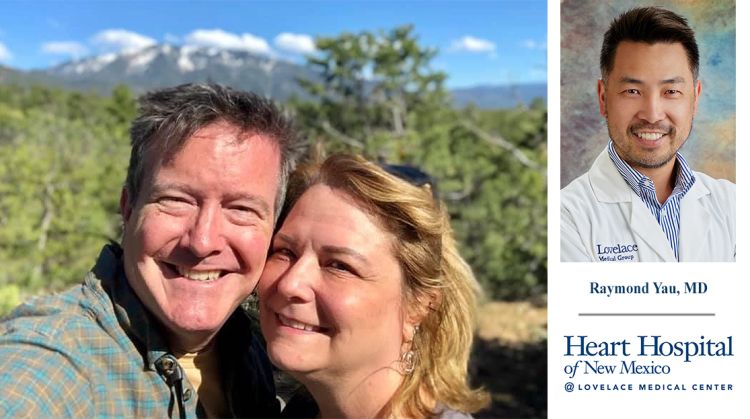
Heart disease is the leading cause of death for women, a condition very familiar to Taos, NM resident Kendra Bealor, 57.
Both sides of Bealor’s family have a history of the disease, so the symptoms of a heart attack are very familiar to her. But she was still surprised when the symptoms struck her one Christmas morning.
“I woke up that morning feeling fine, getting ready for some coffee and opening presents,” recalled Bealor. “Suddenly I felt a lot of pressure in my chest. I started sweating and feeling nauseous. I told my husband that I was having a heart attack. I knew the symptoms because my father had a heart attack when I was young.”
Bealor and her husband drove quickly to the ER at a Taos hospital, where they confirmed the heart attack. The hospital, however, did not have a catheterization lab, so they loaded Bealor into a helicopter for a 27-minute flight to another hospital in Santa Fe.
Despite stabilizing Bealor with a pacemaker, the care team determined that they could not provide the appropriate care to her, so they put her on another helicopter for a flight to Heart Hospital of New Mexico at Lovelace Medical Center.
No ordinary heart attack
“It was at the Heart Hospital that I was diagnosed with a rare heart attack called a Spontaneous Coronary Artery Dissection (SCAD),” said Bealor.
SCAD is the result of a tear inside the coronary artery, allowing blood to create a split between two layers of the wall. This tear may produce a loose flap of tissue on the inside of the artery that could block blood flow and potentially cause a heart attack.
“A SCAD heart attack is more common in women in their 40s and 50s,” said Bealor. “I had no heart attack symptoms before that morning, so it points back to my family’s medical history.”
Doctors determined that Bealor needed surgery to repair the tears in her coronary artery. New Mexico Heart Institute/Lovelace Medical Group interventional cardiologist Raymond Yau, MD, led the surgery to install six stents into Bealor’s artery. The team also performed an angioplasty in her left posterior artery to clear a restricted flow.
Praise for the team
“I spent six days in the ICU before moving to the special care unit for a few more days. They adjusted my medications and monitored my heart rhythm recovery,” said Bealor.
“When I left the ICU in a wheelchair, I asked, ‘Where am I going – on a field trip?’ When they told me I was moving to another room in the special care unit, I said, ‘No, I don’t want to go! Everyone working in the ICU was phenomenal and I didn’t want to leave them!”
Bealor had similar words about the doctors and nurses who cared for her, especially:
“Woody was my first nurse who was so attentive and respectful. After one day, I was relaxed around him because of his compassion and professional manners.”
“Pamela was an attentive and encouraging ICU nurse with a great sense of humor who lifted my spirits. She made sure my husband John was well-informed about my condition.”
“Felicia was a night nurse whose bedside manner was very comforting and encouraging. Her positive and kind attitude made me feel like I was her only focus.”
“Victoria was just on her third week as an RN training on the floor. Victoria's attention to detail was exceptional and I know she will make an outstanding nurse.”
“I was very impressed with Jasmine’s knowledge of nursing and medications. It was clear to me why she was training Victoria. When I was discharged, she went through every medication with detailed instructions. She even gave me a big bear hug that made me feel so important and loved.”
Looking forward
After a month of recuperating, resting and low-impact exercise, Bealor feels back to her normal self. “The first few weeks were a little rough as I felt so weak and fatigued,” she recalled. “But lately I have felt like nothing ever happened to me.”
Bealor also has advice for everyone reading this testimonial: “Listen to your body and don’t ignore unusual symptoms,” she emphasized.
“Make yourself a priority and seek immediate medical attention regardless of what you’re doing. All the doctors and nurses told me that if we hadn’t reacted so quickly to my symptoms, my outcome would’ve been very different, perhaps even the worst case.”
Today, Bealor and her husband are concentrating on building their new home to enjoy during retirement. They started building in 2020 and moved to the area last year. In addition to that work, they look forward to hiking and camping outdoors, and traveling.
“Traveling has been put off to the side as we build the house, but we look forward to traveling to South America, Asia, Europe and especially Croatia. We’d also love to travel to Iceland and see the Northern Lights,” she said.
“I’m so grateful for this second chance in life to make a positive impact in this world. Now back to retirement in paradise!”
To learn more about the signs and symptoms of a heart attack plus tips for a heart-healthy lifestyle, visit our website.



